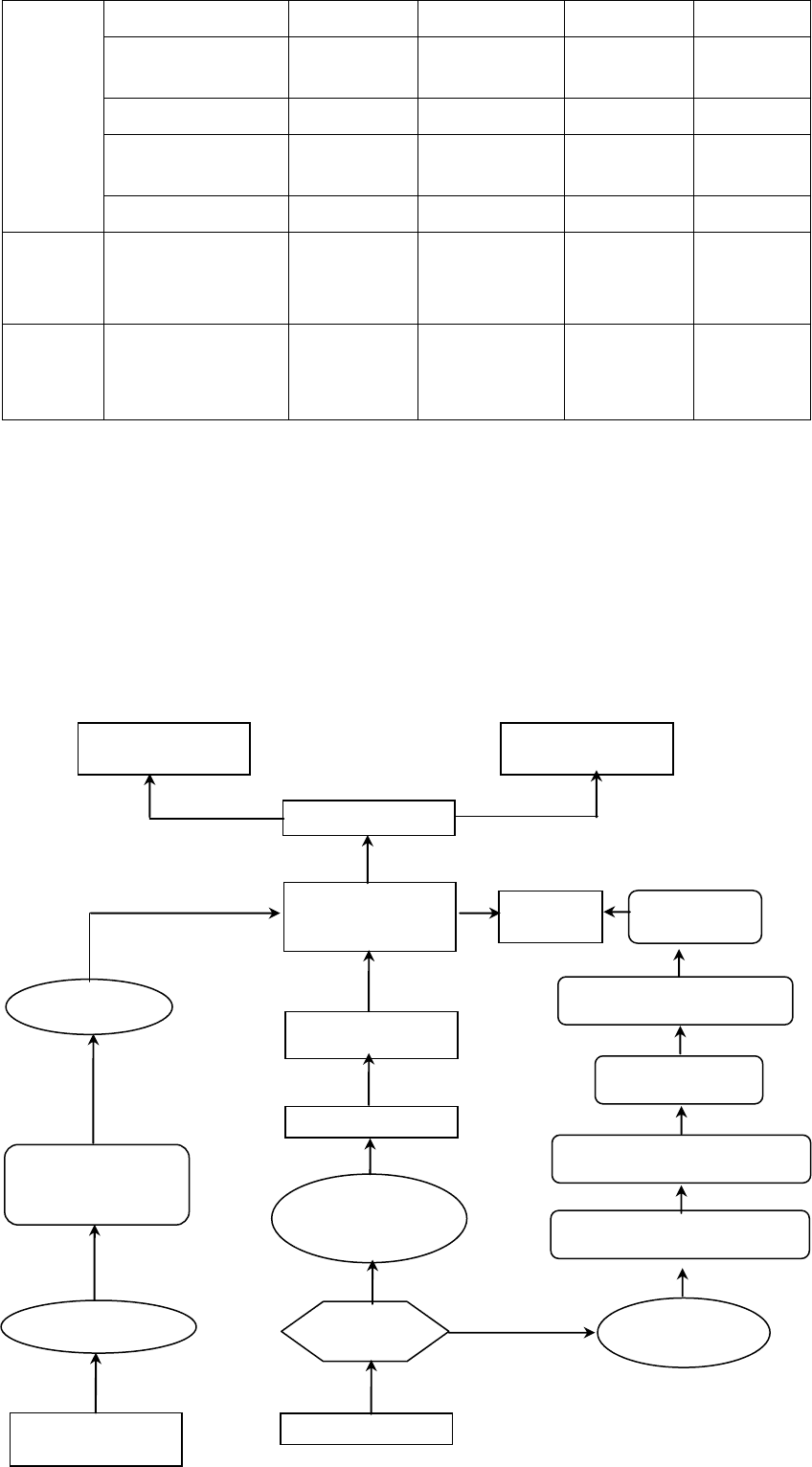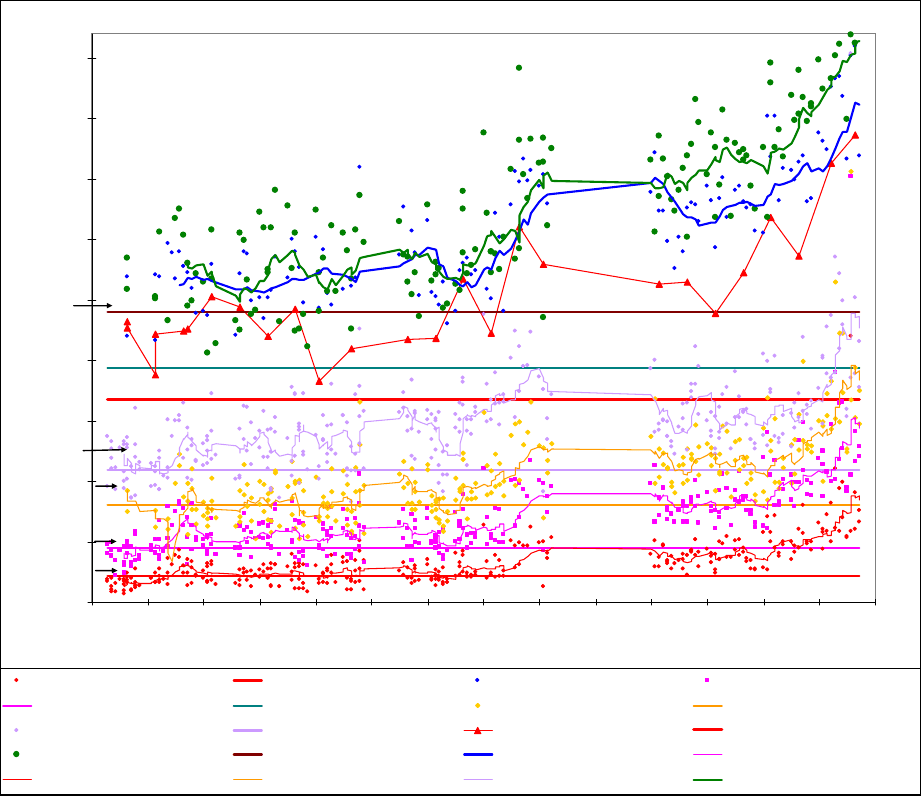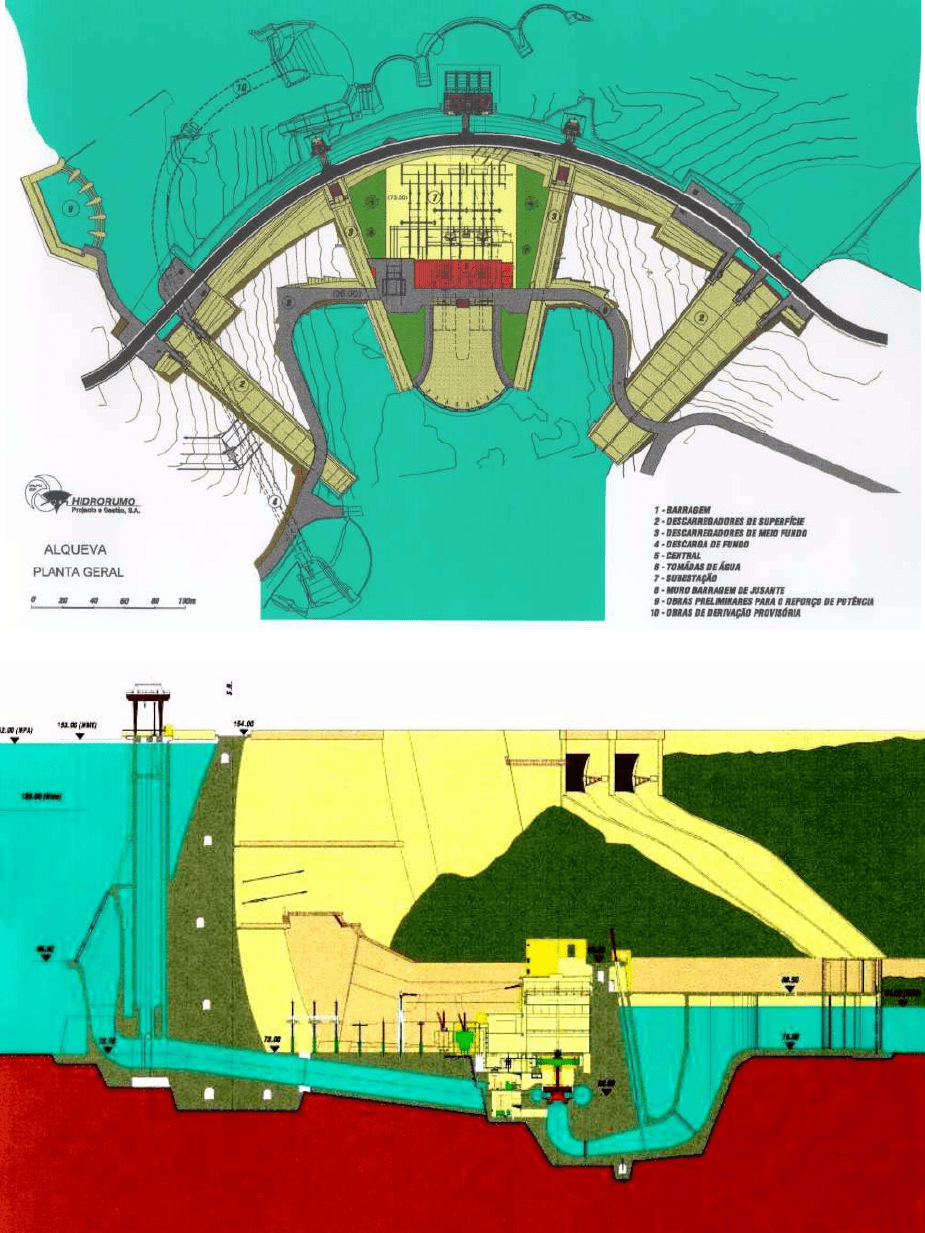International Commission on Large Dams (ICOLD) - The specification and quality control of concrete for dams
Подождите немного. Документ загружается.


ICOLD Bulletin **: The Specification and Quality Control of Concrete for Dams
Revision 7.0
51 of 71
March 2006
construction contract, the contractor offered a value-engineering proposal that modified the
original mix to eliminate the mandatory bedding mix between each lift by making the parent
material richer in paste. The proportions of the value-engineering RCC mix are shown in Table
3. A comparison between the original and value-engineering mixes is summarized in Table 4.
The Contractor proposed this change to increase production by the elimination of the bedding
mix work. A summary of RCC production is shown in Table 5.
Table 2 Original RCC Mix Proportion
kg/ m
3
(Pounds per Cubic Yard) Percent by Weight
Location
Cement Fly Ash Max Water
1.5” x ¾” ¾” x #4 #4 minus
Main Dam
89.1
(150)
74.2
(125)
109.9
(185)
Shaping Blocks
59.4
(100)
59.4
(100)
109.9
(185)
28 24 48
Table 3 Value Engineering (VE) RCC Mix Proportion
kg/ m
3
(Pounds per Cubic Yard) Percent by Weight
Location
Cement Fly Ash Max Water
1.5” x ¾” ¾” x #4 #4 minus
Main Dam
74.2
(125)
121.1
(204)
132.4 (223)
Shaping Blocks
59.4
(100)
133.6
(225)
128.9 (217)
32 29 39
Table 4 Comparison of RCC Mix Properties
Original RCC Mix Value Engineering RCC Mix
Bedding mix between lift? yes no
Weakest materials in tension Parent materials Lift joint
Percentage of fine aggregates 48% 39%
Vebe time 17 to 27 seconds 15 to 17 seconds
Water content
109.9 kg/m
3
(185 lb/ cu yd)
121.1 kg/m
3
(204 lb/ cu yd)
Compressive Strength @ 365 days 20 MPa (3000 psi) 26.9 MPa (3900 psi)
Tensile Strength of the weakest
materials @ 365 days
1.4 MPa (200 psi) 1.5 MPa (220 psi)

ICOLD Bulletin **: The Specification and Quality Control of Concrete for Dams
Revision 7.0
52 of 71
March 2006
Table 5 Summary of RCC Production
Item
Production Rate,
m
3
(yd
3
)
Total
Volume, m
3
(yd
3
)
Last
Recorded
Data, m
3
(yd
3
)
Ratio of (3)
to (4)
(1) (2) (3) (4) (5)
Monthly Average
127,418
(166,656)
132,727
(173,600)
96%
Daily Maximum 614 (802.8) x 20 hrs
12,276
(16,056)
12,218
(15,980)
100.5%
Monthly Max.
9,006 (11,779) x 25
days
225,134
(294,464)
204,366
(267,300)
110.2 %
8.2.3 Project delivery system
There are six main parties that work together with a common goal, i.e. to build a safe, reliable,
durable, and cost-effective emergency storage water reservoir, the Olivenhain Dam Project.
These parties are the owners, San Diego County Water Authority (the Authority) and Olivenhain
Municipal Water District (the District), the regulatory agency, California Department of Water
Resources - Division of Safety of Dams (DSOD), the Board of Senior Consultants (BOSC), the
Construction Management team, the Design Engineer and the Contractor.
The RCC Designer assisted the Design Engineering team in developing the original RCC mix
design. During the development of the value-engineering mix, the Contractor was assisted by the
Specialist RCC Consultant. The interaction among these parties is shown in Figure 2.
8.2.4 Quality control system
The Quality Control (QC) system is depicted in Figure 3. There are two basic elements of the
QC program: testing and inspection. The Contractor has a similar but smaller QC system.
Generally, the Contractor is responsible to make sure the product meets the specification and
drawings. The CM organization conducts the “Record” testing and inspection that is used for
final acceptance and the project record. A table showing the tests performed and the
responsibility distribution is shown in Table 6.

ICOLD Bulletin **: The Specification and Quality Control of Concrete for Dams
Revision 7.0
53 of 71
March 2006
Figure 2 Project Delivery System
Figure 3 Quality Control System
Accuracy and timeliness of test results are the primary goals of testing. These elements are
maintained by regular calibration of the test equipment, development of efficient test procedures
according to standard procedures, calculations, and a computer database. The regular calibration
of test equipment ensures the functional and accuracy of the equipment. Any equipment found
working improperly is clearly marked out of service so that no technician may uses it for testing.
The development of test procedures ensures that the materials are prepared efficiently for
different tests and tested properly in accordance with the standard test procedures, specifications,
and industry standards. The Laboratory Manager carefully watches the implementation of the
test procedures and reviews the test data before entering the data in the computer database. The
computer database recalculates the test calculation for a second check, stores the test data, and
generates the test reports.
Inspection is divided into plant and placement inspections. Quarry, rock crushing, and concrete
and RCC batch plants are the elements of plant inspection. The quarry inspector monitors the
blasting operation of on-site materials. There are safety and operation procedures in place to
ensure safety, environmental compliance, and the quality of the raw materials. The rock crushing
plant inspector monitors the aggregate production and stockpile management and reports any
irregularities during the manufacturing process. During rock production, laboratory technicians
Project Manager
Resident
Engineer/Assistant
Project Manager
Quality Assurance
Manager
Construction
Manager
Laboratory
Manager
Document
Control
Lead Inspector,
Engineer
Field Inspector Field Technician
Laboratory
Technician
Contractor
Kiewit Pacific, Co.
Testing
Kleinfelder, Inc.
Inspection
Washington
Infrastructure
Owner
San Diego County
Water Authority and
Olivenhain Municipal
Water District
Department Safet
y
Of Dams (DSOD)
Board Of Senior
Consultants (BOSC)
Washington
Infrastructure
Construction
Management
Design Engineer
Montgomery Watson
Harza
RCC Designer
Gannett - Fleming
RCC Specialist
Malcolm Dunstan &
Associates
Washington
infrastructure

ICOLD Bulletin **: The Specification and Quality Control of Concrete for Dams
Revision 7.0
54 of 71
March 2006
sample the materials and perform a series of tests to check the quality of materials. For the rock
crushing plant inspector, the gradation test results are the most important information to evaluate
the plant operation. If the gradations are not in compliance with the specifications, adjustments
must be made to the plant to bring the gradations back into compliance. The batch plant
inspectors monitor the proportions of concrete ingredients, workability, and temperature of the
mix. The as-batched proportions of the ingredients are compared to the approved mix design
proportions. They ensure that the aggregate moisture content is included in the proper free water
content added to the mix to comply with the design water/cement ratio. The batch plant
inspectors receive the information on the workability and temperature of the mix from the field
placement inspectors and verify the appropriate changes are made to the design mix if necessary.
The placement inspector monitors the contractor’s methodology and observes the workmanship.
The placement inspectors are in continuous communication with the field technicians who
perform a set of tests on the materials being placed. The field technicians inform the placement
inspectors of the field test results. The inspectors compare their observations and the test results
with the project specifications for compliance and direct changes to the operation if necessary.
The primary elements that are monitored and documented on a RCC placement are the
following: segregation of the mix during transport or placement, proper compaction and densities
are achieved, the mix being placed has the proper workability (VeBe) and temperature, lifts are
placed at the proper thickness and within the specified time allowances from the time the
material is batched. Proper procedures are implemented to ensure full contact and bond with the
abutments and the surfaces are kept moist, clean, and ready for the next lift to be placed.
The Construction Manager is primarily responsible for the coordination of field activities
necessary to support the contractor’s construction activities. This position also handles interface
and coordination with the Design Engineer and DSOD related to the Contractor’s construction
activities.
Table 6 Testing Responsibility Distribution
Responsible Party
Item
Testing
Test Method
Construction
Management
Contractor Supplier
VeBe Consistency C 1170 X X
Density C 1040 X X
Compressive
Strength
C 39 X
Tensile Strength
CRD –
C 164
X
Temperature C 1064 X
RCC
Unit Weight C 1170 X
Gradation C 136 X X
Moisture Content C 566 X X
Particle Shape
D 4791 and
CRD C 120
X
Abrasion C 131 X
Aggregate
Atterberg Limits D 4318 X

ICOLD Bulletin **: The Specification and Quality Control of Concrete for Dams
Revision 7.0
55 of 71
March 2006
Lightweight Mat. C 123 X
Clay Lumps and
Friable Particles
C 142 X
- #200 Wash C 117 X
Specific Gravity
and Absorption
C 127 and C
128
X
Sand Equivalent D 2419 X X
Cement
Physical and
Chemical
Properties
X
Fly Ash
Physical and
Chemical
Properties
X
The Resident Engineer is responsible for the overall QC program. He is responsible for the
interpretation of the plans and specifications, interface with the Design Engineer to respond to
Contractor questions related to the plans and specifications. He reviews all testing report and
distributes it to the necessary entities. He also serves as the first line of contact to DSOD, The
Design Engineer, and the Owner relative to questions or activities concerning the testing
activities.
In order to ensure that the information provided by the QC program was accurate, the Quality
Assurance (QA) program monitors the QC program. The QA program is lead by a QA Manager
who reports directly to the Project Manager. The QA monitors calibration of the equipments,
sampling and testing procedures, plant and placement inspections. The QA Manager conducts
audits and surveillances and reports the findings to the Project Manager and the Resident
Engineer for corrective action.
The Project Manager for the Construction Management team has the ultimate responsibility for
the overall QC/QA program.
Figure 4 Testing and Inspection Report Distribution
Compliance Report/
Inspectors Daily
Report
Non Compliance
Report (NCR)
NCR distributed to Essential
Parties for disposition
Disposition Reviewed by
Resident Engineer and Designer
Contractor Conducts
Corrective Action
NCR is logged
in and closed
Inspector Verify Completion
of Corrective Action
Test Results
Laboratory Manager
Reviews and Enters
test results to Database
Test Reports
Department Safety of
Dams
San Diego County
Water Authority
Project Manager
Resident
Engineer/Assistant
Project Manager
Document
Control
Construction
Manager
Lead Inspector
Field Inspector
Field and Laboratory
Technician
No
Yes
ICOLD Bulletin **:
The Specification and Quality Control of Concrete for Dams
Revision 7.0
56 of 71
March 2006
8.2.5
Official reporting
The test and inspection report distribution diagram is shown in Figure 4. There are two types of
testing: field and laboratory. Field test occurs during concrete or RCC placement. Field
technicians perform a series of tests, record the test results, and inform the field inspectors.
Laboratory tests are performed in the on-site QC laboratory. The Laboratory Manager reviews
the test data before entering in the computer database. The computer database recalculates and
stores the test data. The original test data are filed and at the end of the job these documents will
go to Document Control. At the end of the day, the Laboratory Manager generates reports for the
inspectors. Every week, the Laboratory Manager generates test reports. The Resident Engineer
reviews the reports. After reviewing, the reports the reports are distributed to the Project
Manager, DSOD, the Design Engineer and the Owner.
When inspector observes that the contractor’s work complies with the project specification, the
inspector writes a Daily Field Report (DFR). The DFR is then reviewed by the Lead Inspector
and the Construction Manager. When the inspector observes deviations from the project
specification, a non-compliance report (NCR) is generated and issued. The non-compliance
report is distributed to the responsible party for the non-compliance report for evaluation and a
recommended disposition. The Resident Engineer and Design Engineer review the recommended
disposition. Upon approval from the Resident Engineer and/or Design Engineer, the Contractor
conducts the corrective action. The inspectors verify the completion of the corrective action and
issue a closed NCR. The NCR is reviewed by the Construction Manager, Resident Engineer,
Project Manager, DSOD, and the Owner. If the NCR has modified the design documents it is
then posted as a design change.
8.2.6
Tracking of concrete strength
Figure 5 shows the chart developed to track the strength of the RCC built into the dam. The chart
shows that the control of strength at 365-day maturity can be classed as good with a coefficient
of variation of 12.9%. The results of the tests on specimens subjected to 7-day accelerated cure
are shown to be a good guide to the 365-day strength. The coefficients of variations increase
with lesser maturities and this is typical of high fly-ash mixes.
8.2.7
References
Tarbox, Glenn S., Michael F. Rogers, David E. Kleiner, and Gerard E. Reed, III,
Olivenhain
Dam Design,
Roller-Compacted Concrete For Dams And Dam Rehabilitation, International
Seminar and Construction Tour, San Diego, California, 2002.
Ehasz, J., H. Ehrlich, M. Pauletto, J. Reed, K. Steele, and G. McBain,
Partnering For Success At
the Olivenhain Dam
, Dams – Innovations for Sustainable Water Resources, 22
nd
Annual
USSD Conference, San Diego, California, 2002, p. 389- 397.
Tarbox, Glenn S., Malcolm Dunstan, Russ Grant, Tom Reynoldson, and James Stiady,
Supplementary Olivenhain Dam Trial Mix Program,
Dams – Innovations for Sustainable
Water Resources, 22
nd
Annual USSD Conference, San Diego, California, 2002, p. 271-
285.
Holderbaum, Rodney., Robert A. Kline, Jr., Michael F. Rogers, Randall J. Hartman, and Russell
Grant,
Design of Roller-Compacted Concrete Materials for The Olivenhain Dam
, Dams –

ICOLD Bulletin **:
The Specification and Quality Control of Concrete for Dams
Revision 7.0
57 of 71
March 2006
Innovations for Sustainable Water Resources, 22
nd
Annual USSD Conference, San Diego,
California, 2002, p. 259- 270.
Bennett, Bruce., Tom Reynoldson, Lori Swanson, and James Stiady,
Quality Control
Consideration for Roller-Compacted Concrete,
Dams – Innovations for Sustainable Water
Resources, 22
nd
Annual USSD Conference, San Diego, California, 2002, p. 505 - 516.
Figure 5 Compression test results from quality control programme
3
8
13
18
23
28
33
38
43
48
22-Apr
06-May
20-May
03-Jun
17-Jun
01-Jul
15-Jul
29-Jul
12-Aug
26-Aug
09-Sep
23-Sep
07-Oct
21-Oct
04-Nov
7 day 7 day Target 5.2 MPa. Accelerated 7 day 28 day
28 day targeT 7.6 MPa Accelerated Target 22.4 M Pa 56 day results 56-day target 11.0 M Pa
91-day results 90-day target 13.9 MPa 180 day 180-day target 19.7 MPa
365 day 365 day Target 27 MPa 10 per. Mov. Avg. (Accelerated 7 day) 10 per. Mov. Avg. (28 day )
10 per. Mov. Avg. (7 day) 10 per. Mov. Avg. (56 day results) 10 per. Mov. Avg. (91-day results) 10 per. Mov. Avg. (365 day)
27.0 MPa 365 day
22.4 MPa - 240 day target
coef. var = 31.7%
coef. var. = 21.0%
coef. var.=12.9%
coef. var.=16.6%
coef. var.=14.2%
El.77
0
El.833
El. 883
El. 92
9
El. 97
9
El.805
El.855
El.913
El.95
9
El.985
El. 98
4
El.1011
19.7 MPa - 180 day target
El. 1061
El.103
7
El.108
2
ICOLD Bulletin **:
The Specification and Quality Control of Concrete for Dams
Revision 7.0
58 of 71
March 2006
8.3
ALQUEVA DAM
8.3.1
Introduction
Alqueva is a Portuguese multi-purpose scheme (hydropower, irrigation, flood control, economic
development) located in the South of the country, on the river Guadiana, with a catchment of
48500 km
2
in Spain and 6500 km
2
in Portugal. The reservoir is 83 km long with a capacity of
4.15x10
6
m
3
of which 3.15x10
6
m
3
is live storage.
The dam is a double curvature arch with a maximum height of 96 m and 458 m crest length. The
total volume of concrete is about 700,000 m
3
. The dam body includes one bottom outlet, two
mid-height orifices spillways and two surface spillways with three gates for a design flood of
12,000m
3
/s.
The total concrete volume for the scheme was about 1.23x10
6
m
3
including the dam abutments,
the spillways structures and the powerhouse. This volume was placed between 1998 and 2002.
The Alqueva dam design was developed in several stages. The final stage lasted from 1992 to
1993, and the tender documents were finished in 1994. Impounding started in 2002.
8.3.2
Aggregate evaluation
The identification of possible sources for aggregates production started at the beginning of the
feasibility studies (1972). At that time quarrying and gravel pits exploitation was considered as
shown in Table1. A quarry in the Green Schist was chosen because other rocks showed potential
alkali-aggregate reactivity and/or excessive expansion, either in water or in sulphate solution,
some of the potential quarries were too small and exploitation of gravel pits could not produce
all required sizes of coarse and fine aggregates.
The quantities of aggregates estimated for concrete production were equivalent to 1,100,000 m3,
assuming 93% of for stripping and extraction efficiency. However, the environmental impact
studies showed that the quarry location had to be changed so as not to be visible after filling the
reservoir. This change gave an increased quantity of overburden excavation.
Because it was the first time that this green schist was to be used as concrete aggregate, a
comprehensive evaluation was made of durability, including chemical and physical properties,
with emphasis on alkali-silica reaction, sulphate attack, water expansion and absorption. The
evaluation of mechanical properties included compressive strength, tensile strength, abrasion
resistance and elastic properties. Because of the schistosity, anisotropic characteristics were
determined by testing samples taken both along and perpendicular to the fabric. The rock was
suitable as a source of aggregate except for freezing and thawing issue, which was not
considered in the design because of the essentially frost-free southern location of the dam. This
evaluation lasted from 1973 to 1977, when most of the diversion works were made using
concrete produced with gravel pit aggregates.
Crushing tests were done to evaluate the particle shape of the aggregates produced and losses
during processing. The tests revealed an abnormal quantity of fines passing 0.15 mm sieve (22-
25%). However, after normal processing it was possible to reduce the fines in order to obtain a
good aggregate gradation.

ICOLD Bulletin **:
The Specification and Quality Control of Concrete for Dams
Revision 7.0
59 of 71
March 2006
Figure 1 Alqueva dam layout.

ICOLD Bulletin **:
The Specification and Quality Control of Concrete for Dams
Revision 7.0
60 of 71
March 2006
Table 1 Locations identified as possible origin as raw materials for aggregate production
Quarry sources Gravel pits sources
Type of
rock
Distance from
dam site (km)
Capacity Location Distance from
dam site (km)
Capacity
Green
Schist
Right and left
embankment
(0.5 km to 1 km)
Enough volume
for concrete
production.
Dejebe-Guadiana
confluence.
2 km upstream. Only for fine
aggregates.
Marble
2 km down-
stream.
Enough volume
for concrete
production.
Ardila-Guadiana
confluence.
10km
downstream.
Only for fine
aggregates.
Dolomitic
limestone
12 km by road. Enough volume
for concrete
production.
Insua on the
Guadiana river.
40 km by road. Not enough
volume for coarse
aggregates.
Porphyry
14 km by road. Volume not
evaluated. (*)
Brenhas- Ardila
confluence.
10 km down-
stream.
Only for fine
aggregates.
Gabro
3 km. Not enough
volume.
Granite
40 km by road. Enough volume
for concrete
production.
Tonalite
55 km by road. Volume not
evaluated.
(*) Alkali reactive rock.
The green schist was also evaluated on mortars produced with low heat cement (slag cement
with 40% clinker and 55% of ground granulated blast-furnace slag) comparing strength, water
demand, water absorption, capillarity and water expansion, with mortars moulded using siliceous
sands. Later, tests were made with pozzolanic cement (60% clinker and 35% of class F
pulverized fly ash). The influence of type and rate of admixtures on strength and on water
demand of mortars were also evaluated in this phase.
8.3.3
Mix design and specification of concrete
The first phase of studies (1973/77) included the evaluation on concrete produced with 150 mm
maximum size aggregate. In this phase compressive strength, tensile strength, elasticity and
permeability were measured on cylindrical samples with 450 mm diameter by 900 mm high. The
maximum water/cement ratios were respectively 0.60 and 0.55 in the core of the main dam and
in the concrete used as upstream and downstream facing, In order to achieve these ratios, water
reducing and plasticizing admixtures were used.
Because the works were interrupted during a period of 18 years, a second phase of tests on
mortars and concrete were carried out with another type of cement, a pozzolanic cement with
35% of class F pulverized fly-ash. Tests performed to confirm the properties obtained in the first
phase gave satisfactory results with as much as 20% of fly-ash blended into the pozzolanic
cement. These studies allow the use of 200 kg/m
3
of total cementitious content in the body of the
dam and 240 kg/m
3
in the faces of the dam. This means a total content of 104 kg/m
3
of cement
and 96 kg/m
3
of fly-ash in the dam body and 125kg/m
3
of cement and 115kg/m3 of fly-ash in the
concrete faces, excepted in the upstream toe of the dam where the no fly-ash substitution was
used because the tensile strength requirements given by earthquake loads. Permeability tests
gave results which were low compared to similar projects (1.80x10
-13
m/s)
